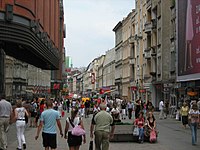Tag:area:highway=pedestrian
| Description |
|---|
| An area representation of pedestrian zones. |
| Group: highways |
| Used on these elements |
| Useful combination |
|
| Status: in use |
| Tools for this tag |
|
An area representation of highway=pedestrian. area:highway=pedestrian describes the shape, i.e. the two-dimensional outline, of the area of a pedestrian street, or parts of it.
It is meant for areas that have a clear direction of travel, and is used as a form of Micromapping in addition to the routable, linear way tagged as highway=pedestrian. Specifically, it is not the same as highway=pedestrian + area=yes, which represents a non-linear area, such as a square or plaza, where multi-directional travel is possible.
How to map
Correct tagging
- If it's a simple pedestrian area, just draw an
 outline around it, and add tag area:highway=pedestrian. Then add a linear highway=pedestrian way through its middle or else most navigation software cannot route correctly through it!
outline around it, and add tag area:highway=pedestrian. Then add a linear highway=pedestrian way through its middle or else most navigation software cannot route correctly through it! - If it's a more complicated one, draw an
 outline around it, tag it with area:highway=pedestrian, draw all inner parts, then select all elements and make a
outline around it, tag it with area:highway=pedestrian, draw all inner parts, then select all elements and make a  multipolygon relation from it. Also add a linear highway=pedestrian way through the middle of all usual paths in the pedestrian area!
multipolygon relation from it. Also add a linear highway=pedestrian way through the middle of all usual paths in the pedestrian area! - Remember to join the areas' edges to surrounding buildings, walls, etc.
[!] For usual footway areas (see differences between highway=pedestrian and highway=footway) use area:highway=footway, and for cycleway areas use area:highway=cycleway
Optional tags:
- surface=* (What is the pedestrian area paved with, if anything? e.g. concrete, asphalt, etc.)
Tagging mistakes to avoid
- Don't leave an area:highway=pedestrian area alone. Always add a linear highway=pedestrian way going through its middle for the area to be routable in navigation software!
- Don't use an area:highway=pedestrian tag to map the area of footways which are too narrow for vehicles to enter. Use area:highway=footway for them.
- Don't draw an area:highway=pedestrian area for pedestrian crossings. Correct tagging of them is explained in a second table below.
- Don't draw an area:highway=pedestrian area for cycleway areas. Use area:highway=cycleway instead.
- Don't use an area:highway=pedestrian tag for non-separated "foot & bicycle" path areas. Use area:highway=path tag instead.
- Don't use an area:highway=pedestrian for traffic calming islands without any crosswalk connection. Use only traffic_calming=island tag instead.
Example tagging
| Case | Area tags | Mapping examples |
|---|---|---|
| area:highway=pedestrian | 
| |
| area:highway=pedestrian Correct tagging of pedestrian multipolygon depends on character of place, you can:
|

|
Example tagging of connected objects
| Case | Way tags | Area tags | Diagrams | Mapping examples | ||
|---|---|---|---|---|---|---|

Pedestrian crossing |
highway=footway |
Draw an area around streets intersection, treating stop lines and crossings as its edges and tag it with:
area:highway=* (class of highway, eg. area:highway=primary) If it's a single crossing being far away from streets intersection, draw it just as a linear way crossing street area without junction=yes tag. |
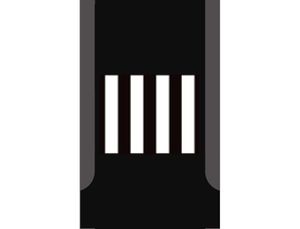
|
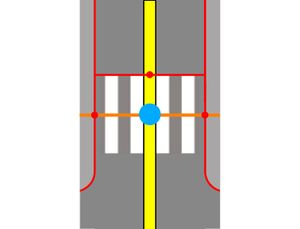
| ||
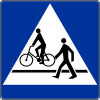
Non-segregated "foot & bicycle" crossing |
highway=path + path=crossing |
Draw an area around streets intersection, treating stop lines and crossings as its edges and tag it with:
area:highway=* (class of highway, eg. area:highway=primary) If it's a single crossing being far away from streets intersection, draw it just as a linear way crossing street area without junction=yes tag. |
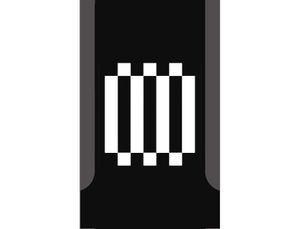
|
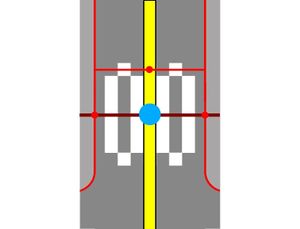
| ||

Segregated "foot & bicycle" crossing |
Method 1 (one linear way):
highway=path |
Draw an area around streets intersection, treating stop lines and crossings as its edges and tag it with:
area:highway=* (class of highway, eg. area:highway=primary) If it's a single crossing being far away from streets intersection, draw it just as a linear way crossing street area without junction=yes tag.
|

|

| ||
Method 2 (two linear ways):
highway=footway
|

|

| ||||

Segregated "foot & bicycle" crossing with traffic calming island |
Method 1 (one linear way): |
Draw an area around streets intersection, treating stop lines and crossings as its edges and tag it with: area:highway=* (class of highway, eg. area:highway=primary) If it's a single crossing being far away from streets intersection, draw it just as a linear way crossing street area without junction=yes tag.
landuse=grass or leisure=garden or traffic_calming=island
|

|

| ||
| highway=path + path=crossing |
highway=path + foot=designated |
highway=path + path=crossing | ||||
Method 2 (two linear ways):
|

|

| ||||
| highway=footway |
highway=footway | highway=footway | ||||
| ||||||
| highway=cycleway |
highway=cycleway | highway=cycleway | ||||
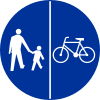
Segregated "foot & bicycle" path |
Method 1 (one linear way):
highway=path (path way should be joined through a mutal part of the footway/ cycleway areas, see example screenshot) |
(both areas should be joined to each other if there is no physical barrier between them, see example screenshot) |
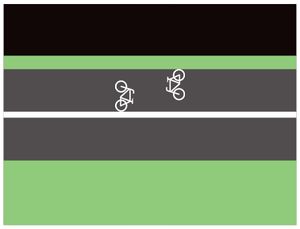
|

| ||
Method 2 (two linear ways):
|

|

| ||||
| Traffic calming paving on a street edge (This element should be treaten as kind of a traffic calming area, not footway) |
traffic_calming=island | 
|
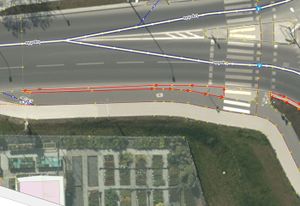
| |||
